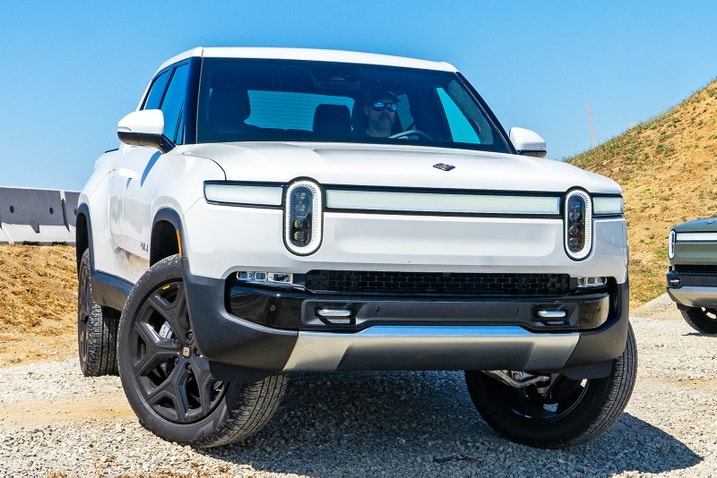- Performance model packs 665 horsepower and 829 lb-ft of torque.
- It does 0-60 mph in 3.5 seconds.
- It stops from 60 mph in 126 feet and pulls 0.85 g on our skidpad.
Tested: 2023 Rivian R1T Performance Dual-Motor Hits 60 MPH Before You Finish Reading This Title
It stops and handles pretty well, too
Rivian has added a new variant to its R1T (truck) and R1S (SUV) lineup. Slotting in between the Dual-Motor AWD and the Quad-Motor AWD, the new Performance Dual-Motor AWD (we'll just call it the Performance from here on out) bridges the gap between the 533-hp standard dual-motor offering and the almost hilariously powerful 835-hp quad-motor variant. Remember, the Rivian R1T is only slightly larger than a Honda Ridgeline and packs 135 hp more than the ridiculous Ford Raptor R in its top trim.
But the Performance marks the introduction of more than just a new model to the lineup. Powering each axle are Rivian's newly designed electric motors. These motors, along with the gearbox and inverter, were designed and engineered by Rivian and are built in-house. This is a major undertaking for what is essentially a small manufacturer, and it could help speed up production as well as help Rivian become less reliant on outside suppliers. That's an article in and of itself, but we're here to see how the new Rivian R1T Performance did at our test track at the hands of America's Best Test Team.
Truckin'
Under the floor of the R1T Performance we tested is Rivian's Large battery pack. The Large pack, however, is actually the smaller of two battery packs you can spec with the Performance model — a Max pack is also available. The standard pack is not offered in this configuration. Rivian has the Performance model pegged at 665 hp and 829 lb-ft of torque so let's see how quickly that much power can move this 6,760-pound electric truck. To the test notes:
- 0-60 mph: 3.5 seconds
- ¼ mile: 12.0 seconds @ 108.5 mph
"It's 2023 so riding in a 6,760-pound electric truck that hits 60 mph in 4.4 seconds is a casual event. But as quick as that time is, that's what the R1T Performance does in its default drive mode — All-Purpose. As with other high-power EVs, the R1T steps off the line smartly and accelerates almost linearly well past 80 mph. Aero drag starts to take its toll on acceleration after that, though the R1T Performance still manages to tap its speed limiter before finishing the quarter mile. Other than wind and electric motor whine, the Rivian is thankfully (personal preference) devoid of a synthesized soundtrack. To get the most out of the R1T Performance, it's a pretty simple process of selecting the Sport drive mode, pointing the truck straight ahead and stomping on the throttle. It shouldn't come as any surprise, but it still is, that the R1T spins its front wheels a bit as it zips off the line. We tried this with the ESC [electronic stability control] on and off and found no difference — 665 hp and 829 lb-ft is gonna do that to a tire. Sport mode harnesses the full power of the R1T and this run was quicker every step of the way. Of note, we test acceleration in every EV with a full state of charge."
For comparison:
Rivian R1T Launch Edition (Quad-Motor)
- 0-60 mph: 3.3 seconds
- ¼ mile: 11.7 seconds @ 110.9 mph
Ford F-150 Lightning Platinum
- 0-60 mph: 4.2 seconds
- ¼ mile: 12.7 seconds @ 106.1 mph
Ford F-150 Raptor R
- 0-60 mph: 4.0 seconds
- ¼ mile: 12.1 seconds @ 112.9 mph
Stoppin' and turnin'
Trucks aren't known for their braking or turning ability. Maybe we can make exceptions for the deceased supercharged Ford Lightning and the equally deceased Toyota Tacoma X-Runner, but most every modern truck just doesn't prioritize performance. So what's the Rivian R1T Performance got to say about that stereotype? Well, it does have Performance in its name. To the notes!
- 60-0 mph: 126 feet
- 0.85 g on our skidpad
"There are small sedans that take a longer distance to stop from 60 than this 6,760-pound electric truck — I'm looking at you, Volkswagen Jetta. The brakes feel much better than ones in any other truck I've tested and provide decent feedback through the pedal. With the truck in Sport mode and the suspension in its firmest setting, nosedive is far less than you'd expect. Stability is also very good. So, while a 126-foot stopping distance is nothing to sneeze at, it's worth noting that the 7,148-pound R1T Launch Edition we tested in late 2021 stopped in 117 feet on the same surface. We chalk that up to the tires. Even though they are the same size, and even the same brand, they are not the same model. The construction of the tires on the R1T Performance just don't have the same stick as the tires on the Launch Edition."
Now to the skidpad. Physics remains the undefeated champion, but the Rivian did put up a good fight.
"Like the R1T's acceleration, the way it just goes around the skidpad, casually outhandling pretty much every other truck (except for that pesky R1T Launch Edition) is almost a non-event. It's actually pretty easy to do this because the Rivian is working hard so you don't have to. I really like the steering wheel in this thing. Fairly slim rim by modern standards and it has a quicker steering rack than most trucks, too. That makes it feel a touch more responsive on initial turn-in. Even in its All-Purpose drive mode, the R1T's stability control does a really good job of staying out of the way. Body roll isn't nearly as much as you'd expect in this mode. Switching to Sport mode, dropping the ride height of the truck to its lowest setting and disabling ESC lets you eke out just a bit more speed from the R1T. Understeer is the dominant trait, even if you do try to get a little playful, but the Rivian feels stable, safe and secure. Real torque vectoring (the kind you can only get with four motors) and better tires would make the R1T almost surreal."
The tires on the R1T Performance were Pirelli Scorpion Zero Elects with a 500 treadwear rating in 275/50R22. They're classified as an all-season tire and are HL rated. That HL is short for "high load" and it's a new load rating above SL and XL (standard and extra load) developed for the influx of larger and heavier electric vehicles. This rating ensures the tires are up to the task of carrying around these EVs without having to run higher tire pressures, which could degrade ride quality and make for more tire noise. But, with a focus on low rolling resistance for better efficiency and a construction that prioritizes load management over performance, outright performance takes a back seat with this style of tire, even if the word Performance is in the name of the vehicle.
How much of a drop in performance did we see with these tires? Well, the aforementioned Quad-Motor R1T we tested ran on Pirelli Scorpion Verde all-season tires in 275/55R21. They had a treadwear rating of 600 and were not HL rated. It's also worth noting that the Quad-Motor tipped our scales at 7,148 pounds and was tested at the same facility on the same asphalt.
For comparison:
Rivian R1T Launch Edition (Quad-Motor)
- 60-0 mph: 117 feet
- 0.87 g on our skidpad
Ford F-150 Lightning Platinum
- 60-0 mph: 127 feet
- 0.78 g on our skidpad
Ford F-150 Raptor R
- 60-0 mph: 147 feet
- 0.72 g on our skidpad
How far are we going?
What article about any EV would be complete without at least a brief mention of range? EPA estimates for the Performance Dual-Motor depend on the wheel and tire package: 307 miles with 20-inch all-terrain tires, 352 miles for the 21-inch wheels, and 341 miles with the 22-inch wheels like the ones on our test vehicle. Just like with performance, tires have a lot to do with driving range. The smaller 20-inch wheels run chunky all-terrains that have much more rolling resistance than the 21- and 22-inch wheels. But the size of the wheel and tire package can also come into play since a lighter package, in this case with the 21-inch wheels, means the motors don't have to work as hard to make the wheels rotate.
Since our time with the R1T Performance was limited to performance testing, we didn't have time to put the vehicle through our real-world EV range test. Once the R1T Performance becomes available for a more in-depth test by our editors, check back with us for the results of the range test.
Edmunds says
With its 11,000-pound tow rating, the ability to hit 60 mph in 3.5 seconds, impressive handling and an EPA-estimated range of 341 miles, the Rivian R1T Performance Dual-Motor is about as close to a Swiss Army knife as you can get these days. Even though the Quad-Motor version is a bit quicker and possesses amazing off-road capability, we don't think you're giving up much, if any, day-in, day-out practicality or performance with the Dual-Motor. As a bonus, you can save a chunk of money going with the Dual-Motor and use that to buy some overlanding gear. Of course, the performance junkies in us want to see what an R1T could do with a really good set of summer tires. Maybe we can get Rivian to let us drive one up Pikes Peak next year. Please, Rivian?






 by
by